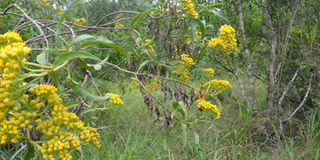Allure of Oloolua

Forest flower in Oloolua forest. PHOTO | RUPI MANGAT
What you need to know:
- This magnificent raptor of the African skies became really famous when the internationally respected Dr Leslie Brown began studying it from the 1960s.
- The eminent ornithologist asked Simon Thomsett who was just a teenager to watch over the nest of raptors known as Oloolua crowned eagles.
- There’s no crowned eagle in sight. Instead, looking down a footprint is stamped on the wet earth – that of a water-buck close to the mouth of a cave. Reputed to be a Mau Mau cave, it’s a maze of impenetrable darkness.
It’s a lazy Sunday and wanting to burn off calories from a heavy, healthy breakfast at Karen Blixen Coffee Garden, we head to Oloolua Forest down the road where the Bursell family who managed Karen Blixen’s coffee farm in the 60s had seen a pair of African crowned eagles.
This magnificent raptor of the African skies became really famous when the internationally respected Dr Leslie Brown began studying it from the 1960s. The eminent ornithologist asked Simon Thomsett who was just a teenager to watch over the nest of raptors known as Oloolua crowned eagles.
“I felt very honoured,” reminisces Thomsett in an email to me, “because these eagles were living legends in his books, which at the time were some of the only works on eagles in the world.”
It’s a little bit of history being passed on by raptor guru Thomsett. He is a research associate at the National Museums of Kenya ornithology section and a trustee of the Kenya Birds of Prey.
While frequently visiting Oloolua forest to watch over the pair of crowned eagles, Thomsett had plenty of time to discover Oloolua’s magical world from the 1960s to 1990s.
“I remember Ololua having many bushbuck, suni and common duiker as well as leopard and spotted hyena. We had a palm civet delivered by the eagles to the nest, indicating a very healthy forest. The eagles would kill mostly antelopes, followed by monkeys, mostly Sykes monkeys,” he shares.
Walking over the bridge straddling Mbagathi River, we’re in the forest that’s bursting green because of the rains with the river in full spate. I go back to Thomsett’s email.
TALL HIDEOUT
“In 1979, Leslie died and the Institute for Primate Research (IPR) built the centre in the forest,” writes Thomsett. Although the centre saved much of the forest, it cut half the tree that the eagles had built a nest on instead of making a detour around the tree. The pair moved downstream to one of the two ancient nest sites.
In 1986, Thomsett built a wooden hideout for Alan Root, who pioneered wildlife films in Kenya, to film the nest. It was great for the chick perched within a foot of the hideout.
Another tall hideout was built for the crowds to see the nest from a safe distance funded by the Peregrine Fund and I’m standing by it, but it’s locked. Benches in amphitheatre style are built around it. We continue our hike.
The hideout worked for a while but as Thomsett shares, the female crowned eagle was hit in the eye by an antelope horn or stick. “I had to catch her and do an eye operation at the eye unit at the PCEA Kikuyu Hospital. This information is captured in a documentary by Richard Brock.
“I put the first captive bred crowned eagle in the world (bred at Athi) under the adults to try and get them to stay despite a nesting failure. With a film crew breathing over my shoulder I had to hurry it. But the chick was nearly killed by the male so I had to rush back up the tree to get it back.

Forest flower in Oloolua forest. PHOTO | RUPI MANGAT
“The pair was still to be heard years later and hopefully bred elsewhere,” finishes Thomsett.
There’s no crowned eagle in sight. Instead, looking down a footprint is stamped on the wet earth – that of a water-buck close to the mouth of a cave. Reputed to be a Mau Mau cave, it’s a maze of impenetrable darkness. A few steps crouched inside is enough for me, hoping to see bats, but I see none.
The path leads us to an enchanted glade of forest with dry leaves on the earth. Large burrows by the trees reveal the presence of aardvarks or porcupines.
Two hours later we’re out of the forest, refreshed from the good forest air. Urban cities like Nairobi need these open, natural spaces to soak in the carbon from the cars we drive, but instead we chop the trees and erase the lawns to put up apartment blocks.
FACT FILES
Oloolua forest is 250 hectares of indigenous tropical dry forest and home of the Institute of Primate Research (IPR). There’s a picnic site complete with benches, drop toilets and trash bins.
To explore the 33-metre-long cave, carry a flashlight.
For the more intrepid, spend a night out in Oloolua forest – it’s got running water, drop toilets, and firewood for a bonfire. You’ll have to bring your own tent, food and cooking utensils though.




